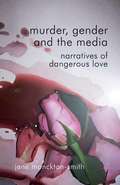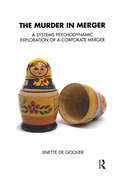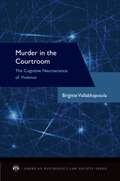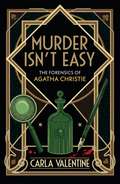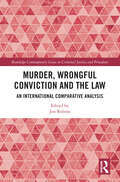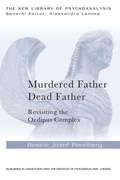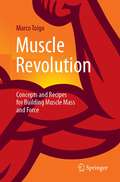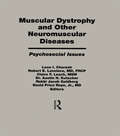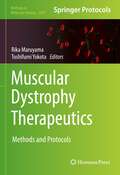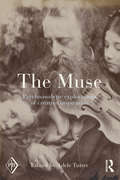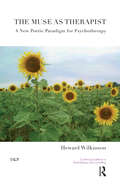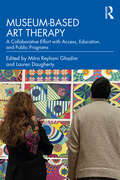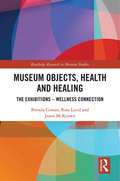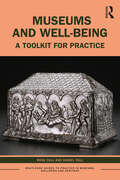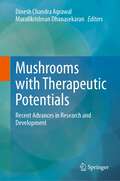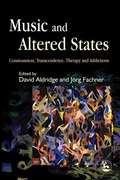- Table View
- List View
Murder, Gender and the Media: Narratives of Dangerous Love
by Jane Monckton-SmithA shocking look at how the idea of romantic love can justify and excuse the killing of women by their partners, and lead to sympathy and reduced sentences for the killers. The author explores how stories of domestic homicide are told in the news, by the police, and in the courts, drawing from 72 cases which took place over a twelve month period.
The Murder in Merger: A Systems Psychodynamic Exploration of a Corporate Merger
by Jinette De GooijerThis book provides an overview of the psychodynamics theory, bringing together concepts from the field within a particular focus, that of "emotional connectedness". It is for managers who are involved in facilitating the transitions of enterprises as they form into a newly merged entity.
The Murder in Merger: A Systems Psychodynamic Exploration of a Corporate Merger
by Jinette De GooijerThis book provides an overview of the psychodynamics theory, bringing together concepts from the field within a particular focus, that of "emotional connectedness". It is for managers who are involved in facilitating the transitions of enterprises as they form into a newly merged entity.
Murder in the Courtroom: The Cognitive Neuroscience of Violence (American Psychology-Law Society Series)
by Brigitte VallabhajosulaAnswers to many legal questions often depend on our understanding of the relationship between the human brain and behavior. While there is no evidence to suggest that violence is the sole result of cognitive impairment, research does suggest that frontal lobe impairment in particular may contribute to the etiology of violent behavior. Murder in the Courtroom presents a comprehensive and detailed analysis of issues most relevant to answering questions regarding the link between cognitive functioning and violence. It is the first book to focus exclusively on the etiology and assessment of cognitive impairment in the context of violent behavior and the challenges courts face in determining the reliability of neuroscience evidence; provide objective discussions of currently available neuropsychological tests and neuroimaging techniques, and their strengths and limitations; provide a methodology for the assessment of cognitive dysfunction in the context of violent behavior that is likely to withstand a Daubert challenge; and include detailed discussions of criminal cases to illustrate important points. Clinical and forensic psychologists and psychiatrists, cognitive neuroscientists, and legal professionals will be able to use this book to further their understanding of the relationship between brain function and extreme violence.
Murder Isn't Easy: The Forensics of Agatha Christie
by Carla ValentineAgatha Christie is one of our most beloved authors - a storyteller unparalleled in her clever plots and twisting tales. But Agatha was also a forensic expert; in each of her books she employs an expert weaving of human observation, ingenuity and genuine science of the era.In Murder Isn't Easy Carla Valentine illuminates all of Agatha's incredible knowledge, showing how she stayed at the cutting edge of forensics from ballistics to fingerprint analysis, as seen through much-loved characters such as Poirot and Miss Marple.From the glamour and grit of Agatha Christie's stories, to the real-life cases that inspired them, Murder Isn't Easy will immerse you in the forensics that influenced generations of writers and scientists alike.
Murder, Wrongful Conviction and the Law: An International Comparative Analysis (Routledge Contemporary Issues in Criminal Justice and Procedure)
by Jon RobinsThis collection brings together international experts to present a comparative analysis of wrongful conviction and criminal procedure. The volume takes an interdisciplinary approach with authors drawn from a broad range of backgrounds including law, psychology, forensics and journalism. All are experts in their field with direct experience of the investigation of wrongful conviction in their own countries. Focusing on the main areas of concern in their own jurisdiction, each author discusses common themes, including: the extent of the problem; the types of cases that feature in miscarriages of justice; the legal mechanism for the correction of a wrongful conviction; compensation for the wrongly convicted; public awareness and concern about the issue generally and in light of highprofile cases; and the extent to which wrongful conviction has driven criminal justice reform. The book will be essential reading for students, researchers and policy-makers interested in comparative law, criminology and psychology.
Murder, Wrongful Conviction and the Law: An International Comparative Analysis (Routledge Contemporary Issues in Criminal Justice and Procedure)
by Jon RobinsThis collection brings together international experts to present a comparative analysis of wrongful conviction and criminal procedure. The volume takes an interdisciplinary approach with authors drawn from a broad range of backgrounds including law, psychology, forensics and journalism. All are experts in their field with direct experience of the investigation of wrongful conviction in their own countries. Focusing on the main areas of concern in their own jurisdiction, each author discusses common themes, including: the extent of the problem; the types of cases that feature in miscarriages of justice; the legal mechanism for the correction of a wrongful conviction; compensation for the wrongly convicted; public awareness and concern about the issue generally and in light of highprofile cases; and the extent to which wrongful conviction has driven criminal justice reform. The book will be essential reading for students, researchers and policy-makers interested in comparative law, criminology and psychology.
Murdered Father, Dead Father: Revisiting the Oedipus Complex (The New Library of Psychoanalysis)
by Rosine Jozef PerelbergMurdered Father, Dead Father: Revisiting the Oedipus Complex examines the progressive construction of the notion of paternal function and its central relevance in psychoanalysis. The distinction between the murdered (narcissistic) father and the dead father is seen as providing a paradigm for the understanding of different types of psychopathologies, as well as works of literature, anthropology and historical events. New concepts are introduced, such as "a father is being beaten", and a distinction between the descriptive après coup and the dynamic après coup that provides a model for a psychoanalytic understanding of temporality. The book includes a reflection on how the concepts of the death instinct and the negative, in their connection with that which is at the limits of representability, are an aid to an understanding of Auschwitz, a moment of rupture in European culture that the author characterizes as " the murder of the dead father". Perelberg’s book is an important clinical and intellectual marker, and will be required reading for psychoanalysts, psychotherapists, anthropologists, and historians, as well as students in all these disciplines.
Murdered Father, Dead Father: Revisiting the Oedipus Complex (The New Library of Psychoanalysis)
by Rosine Jozef PerelbergMurdered Father, Dead Father: Revisiting the Oedipus Complex examines the progressive construction of the notion of paternal function and its central relevance in psychoanalysis. The distinction between the murdered (narcissistic) father and the dead father is seen as providing a paradigm for the understanding of different types of psychopathologies, as well as works of literature, anthropology and historical events. New concepts are introduced, such as "a father is being beaten", and a distinction between the descriptive après coup and the dynamic après coup that provides a model for a psychoanalytic understanding of temporality. The book includes a reflection on how the concepts of the death instinct and the negative, in their connection with that which is at the limits of representability, are an aid to an understanding of Auschwitz, a moment of rupture in European culture that the author characterizes as " the murder of the dead father". Perelberg’s book is an important clinical and intellectual marker, and will be required reading for psychoanalysts, psychotherapists, anthropologists, and historians, as well as students in all these disciplines.
Muscle Revolution: Concepts and Recipes for Building Muscle Mass and Force
by Marco ToigoHow to Effectively and Efficiently Build Muscle Mass and Muscle ForceIn this informative as well as practical book based on the latest integrative muscle research, Marco Toigo, PhD, describes which factors are crucial to successfully build muscle mass and muscle force through resistance training. In addition, he presents the practical and science-based consequences for your training and nutritional behavior with a focus on protein intake. This work thus offers both a practical guide and a scientific explanation of the "why" and "how" of effective and efficient resistance training.This book is the English version of the very successful 2nd German edition of “MuskelRevolution“ (ISBN: 978-3-662-54764-9). The translation was done with the help of artificial intelligence. A subsequent human revision was done primarily in terms of content.
Muscular Dystrophy and Other Neuromuscular Diseases: Psychosocial Issues
by Leon I. Charash Roye P. David Robert E. Lovelace Leach F. Claire Kutscher H. Austin Goldberg JacobHere is a thoughtful new book for professionals who assist persons afflicted with neuromuscular disorders to help them and their families adapt to lifestyle changes accompanying the onset of these disorders. Health care professionals provide strategies to maintain the psychosocial well-being of children and adults with neuromuscular disorders which, in addition to physical damage, also assault the sense of self and challenge the individual’s ability to move and communicate. Chapters describe the psychosocial aspects of a variety of neuromuscular diseases such as Duchenne and myotonic muscular dystrophy, multiple sclerosis, amyotrophic lateral sclerosis, Friedeich’s ataxia, and Charcot-Marie-Tooth disease. The distinctive characteristics of each disease are examined with special attention given to the natural history, treatment, management, and psychosocial issues of the specific disorder. Beyond the clinical and research importance of Muscular Dystrophy and Other Neuromuscular Diseases, it also addresses the anxiety, doubts, and questions felt by patients with chronic progressive disabilities and their families. This helpful guide is unique in the way it features the interaction of professionals in the social services, psychology, religion, and various medical specialties in the care and treatment of these patients. Professionals in all of these disciplines, as well as the patients and families afflicted by these disorders, will benefit from this valuable resource.
Muscular Dystrophy and Other Neuromuscular Diseases: Psychosocial Issues
by Leon I. Charash Robert E. Lovelace Claire F. Leach Austin H. Kutscher Rabbi Jacob Goldberg David Price RoyeHere is a thoughtful new book for professionals who assist persons afflicted with neuromuscular disorders to help them and their families adapt to lifestyle changes accompanying the onset of these disorders. Health care professionals provide strategies to maintain the psychosocial well-being of children and adults with neuromuscular disorders which, in addition to physical damage, also assault the sense of self and challenge the individual’s ability to move and communicate. Chapters describe the psychosocial aspects of a variety of neuromuscular diseases such as Duchenne and myotonic muscular dystrophy, multiple sclerosis, amyotrophic lateral sclerosis, Friedeich’s ataxia, and Charcot-Marie-Tooth disease. The distinctive characteristics of each disease are examined with special attention given to the natural history, treatment, management, and psychosocial issues of the specific disorder. Beyond the clinical and research importance of Muscular Dystrophy and Other Neuromuscular Diseases, it also addresses the anxiety, doubts, and questions felt by patients with chronic progressive disabilities and their families. This helpful guide is unique in the way it features the interaction of professionals in the social services, psychology, religion, and various medical specialties in the care and treatment of these patients. Professionals in all of these disciplines, as well as the patients and families afflicted by these disorders, will benefit from this valuable resource.
Muscular Dystrophy Therapeutics: Methods and Protocols (Methods in Molecular Biology #2587)
by Toshifumi Yokota Rika MaruyamaThis detailed book presents a comprehensive collection of state-of-the-art protocols on muscular dystrophy therapeutics, covering therapeutics using antisense oligonucleotides, gene replacement, genome editing, small molecules, stem cells, and antibodies. Written by leaders in the field, the volume explores techniques that are currently in use and are starting an exciting therapeutic revolution in muscular dystrophy. As a part of the highly successful Methods in Molecular Biology series, chapters include introductions to their respective topics, lists of the necessary materials and reagents, step-by-step and readily reproducible laboratory protocols, as well as tips on troubleshooting and avoiding known pitfalls. Authoritative and practical, Muscular Dystrophy Therapeutics: Methods and Protocols serves as an ideal resource to inspire readers and provide tips, strategies, and advice to develop new therapeutic technologies for this group of diseases.
The Muse: Psychoanalytic Explorations of Creative Inspiration (Psychoanalytic Inquiry Book Series)
by Adele TutterPsychoanalysts have long been fascinated with creative artists, but have paid far less attention to the men and women who motivate, stimulate, and captivate them. The Muse counters this trend with nine original contributions from distinguished psychoanalysts, art historians, and literary scholars—one for each of the nine muses of classical mythology—that explore the muses of disparate artists, from Nicholas Poussin to Alison Bechdel. The Muse breaks new ground, pushing the traditional conceptualization of muses by considering the roles of spouse, friend, rival, patron, therapist—even a late psychoanalytic theorist—in facilitating creativity. Moreover, they do so not only by providing inspiration, but also by offering the artist needed material and emotional support; tolerating competitive aggression; promoting reflection and insight; and eliciting awe, anxiety and gratitude. Integrating art history and literary criticism with a wide spectrum of contemporary psychoanalytic perspectives, The Muse is essential reading for psychoanalysts and psychotherapists interested in the relationships that enhance and support creative work. Fully interdisciplinary, it is also accessible to readers in the fields of art, art history, literature, memoir, and film. The Muse sheds new light on that most mysterious dyad, the artist and muse—and thus on the creative process itself.
The Muse: Psychoanalytic Explorations of Creative Inspiration (Psychoanalytic Inquiry Book Series)
by Adele TutterPsychoanalysts have long been fascinated with creative artists, but have paid far less attention to the men and women who motivate, stimulate, and captivate them. The Muse counters this trend with nine original contributions from distinguished psychoanalysts, art historians, and literary scholars—one for each of the nine muses of classical mythology—that explore the muses of disparate artists, from Nicholas Poussin to Alison Bechdel. The Muse breaks new ground, pushing the traditional conceptualization of muses by considering the roles of spouse, friend, rival, patron, therapist—even a late psychoanalytic theorist—in facilitating creativity. Moreover, they do so not only by providing inspiration, but also by offering the artist needed material and emotional support; tolerating competitive aggression; promoting reflection and insight; and eliciting awe, anxiety and gratitude. Integrating art history and literary criticism with a wide spectrum of contemporary psychoanalytic perspectives, The Muse is essential reading for psychoanalysts and psychotherapists interested in the relationships that enhance and support creative work. Fully interdisciplinary, it is also accessible to readers in the fields of art, art history, literature, memoir, and film. The Muse sheds new light on that most mysterious dyad, the artist and muse—and thus on the creative process itself.
The Muse as Therapist: A New Poetic Paradigm for Psychotherapy
by Heward WilkinsonIn recent years there has been a cautious movement towards seeing psychotherapy and counselling as arts not as sciences. In this rich, yet rigorous, multidisciplinary text, this movement is explored in terms of poetry; therapy; dreams; literary texts; Heideggerian, Kantian, and post-modern philosophy; the modern developmental theorising of Daniel Stern; and the politics of psychotherapy regulation. This path-breaking book offers a grounded challenge to reductive visions of the therapy process.
The Muse as Therapist: A New Poetic Paradigm for Psychotherapy (The\united Kingdom Council For Psychotherapy Ser.)
by Heward WilkinsonIn recent years there has been a cautious movement towards seeing psychotherapy and counselling as arts not as sciences. In this rich, yet rigorous, multidisciplinary text, this movement is explored in terms of poetry; therapy; dreams; literary texts; Heideggerian, Kantian, and post-modern philosophy; the modern developmental theorising of Daniel Stern; and the politics of psychotherapy regulation. This path-breaking book offers a grounded challenge to reductive visions of the therapy process.
Museum-based Art Therapy: A Collaborative Effort with Access, Education, and Public Programs
by Mitra Reyhani Ghadim Lauren DaughertyThis practical and inspirational resource offers a wide range of information about museum-based art therapy and wellness programming in various museums. Featuring contributions from art therapists and access professionals from various museum-based wellness programs, the book describes museum-based art therapy, education, access, and inclusion to enlarge the scope of professional development and higher education training in art therapy and its relation to museum studies. Chapter examples of successful museum art therapy and wellness initiatives increase awareness about the role of art therapy in museums and the role of museums in building healthy societies and improving lives. The text also contributes to the field of art therapy by deconstructing traditional narratives about therapy being conceived only as a clinical treatment, and by introducing arts-based approaches and strategies in museums as expanding territories for being proactive in community health and wellness. Museum-based Art Therapy is a valuable guide for art students who are interested in working in museum education, access and disabilities, or museum studies, and graduates and professionals working across the disciplines of museums, art therapy, and disability studies.
Museum-based Art Therapy: A Collaborative Effort with Access, Education, and Public Programs
by Mitra Reyhani Ghadim Lauren DaughertyThis practical and inspirational resource offers a wide range of information about museum-based art therapy and wellness programming in various museums. Featuring contributions from art therapists and access professionals from various museum-based wellness programs, the book describes museum-based art therapy, education, access, and inclusion to enlarge the scope of professional development and higher education training in art therapy and its relation to museum studies. Chapter examples of successful museum art therapy and wellness initiatives increase awareness about the role of art therapy in museums and the role of museums in building healthy societies and improving lives. The text also contributes to the field of art therapy by deconstructing traditional narratives about therapy being conceived only as a clinical treatment, and by introducing arts-based approaches and strategies in museums as expanding territories for being proactive in community health and wellness. Museum-based Art Therapy is a valuable guide for art students who are interested in working in museum education, access and disabilities, or museum studies, and graduates and professionals working across the disciplines of museums, art therapy, and disability studies.
Museum Objects, Health and Healing: The Relationship between Exhibitions and Wellness (Routledge Research in Museum Studies)
by Brenda Cowan Ross Laird Jason McKeownMuseum Objects, Health and Healing provides an innovative and interdisciplinary study of the relationship between objects, health and healing. Shedding light on the primacy of the human need for relationships with objects, the book explores what kind of implications these relationships might have on the exhibition experience. Merging museum and object studies, as well as psychotherapy and the psychology of well-being, the authors present a new theory entitled Psychotherapeutic Object Dynamics, which provides a cross- disciplinary study of the relationship between objects, health and well-being. Drawing on primary research in museums, psychotherapeutic settings and professional practice throughout the US, Canada, Bosnia-Herzegovina and the UK, the book provides an overview of the theory’s origins, the breadth of its practical applications on a global level, and a framework for further understanding the potency of objects in exhibitions and daily life. Museum Objects, Health and Healing will be essential reading for academics, researchers and postgraduate students interested in museum studies, material culture, mental health, psychotherapy, art therapies and anthropology. It should also be valuable reading for a wide range of practitioners, including curators, exhibition designers, psychologists, and psychotherapists.
Museum Objects, Health and Healing: The Relationship between Exhibitions and Wellness (Routledge Research in Museum Studies)
by Brenda Cowan Ross Laird Jason McKeownMuseum Objects, Health and Healing provides an innovative and interdisciplinary study of the relationship between objects, health and healing. Shedding light on the primacy of the human need for relationships with objects, the book explores what kind of implications these relationships might have on the exhibition experience. Merging museum and object studies, as well as psychotherapy and the psychology of well-being, the authors present a new theory entitled Psychotherapeutic Object Dynamics, which provides a cross- disciplinary study of the relationship between objects, health and well-being. Drawing on primary research in museums, psychotherapeutic settings and professional practice throughout the US, Canada, Bosnia-Herzegovina and the UK, the book provides an overview of the theory’s origins, the breadth of its practical applications on a global level, and a framework for further understanding the potency of objects in exhibitions and daily life. Museum Objects, Health and Healing will be essential reading for academics, researchers and postgraduate students interested in museum studies, material culture, mental health, psychotherapy, art therapies and anthropology. It should also be valuable reading for a wide range of practitioners, including curators, exhibition designers, psychologists, and psychotherapists.
Museums and Well-being (Routledge Guides to Practice in Museums, Galleries and Heritage)
by Rose Cull Daniel CullMuseums and Well-being outlines the historical development of well-being within museums and offers a critical engagement with this field from a museum studies perspective. The essential thesis of the book is that well-being is a collective action. The book utilises the Five Ways to Well-being as a model: Connect, Be Active, Keep Learning, Give and Take Notice. Each of these Ways are explored through a specific museum object illustrating the important role collections can play in museum well-being. The book considers how museum well-being, and the austerity project became entwined, and how the COVID-19 pandemic supercharged growth in this field. The book explores such diverse topics as walking, slow art, social capital, Virginia Woolf, body positivity, collective joy, identity, art therapy, yoga, Squid Game, Effective Altruism, mindfulness, gift exchange, the Preston model, the limits of data, sketching, photography, inclusive spaces, and workplace well-being. The book signposts a vast array of existing information, and offers a critical engagement with current practices. Museums and Well-being is aimed initially to students of museum studies programmes, it is also an ideal book for museum staff who need to add a well-being component to their existing programming; or to reconsider existing programming from the perspective of well-being.
Museums and Well-being (Routledge Guides to Practice in Museums, Galleries and Heritage)
by Rose Cull Daniel CullMuseums and Well-being outlines the historical development of well-being within museums and offers a critical engagement with this field from a museum studies perspective. The essential thesis of the book is that well-being is a collective action. The book utilises the Five Ways to Well-being as a model: Connect, Be Active, Keep Learning, Give and Take Notice. Each of these Ways are explored through a specific museum object illustrating the important role collections can play in museum well-being. The book considers how museum well-being, and the austerity project became entwined, and how the COVID-19 pandemic supercharged growth in this field. The book explores such diverse topics as walking, slow art, social capital, Virginia Woolf, body positivity, collective joy, identity, art therapy, yoga, Squid Game, Effective Altruism, mindfulness, gift exchange, the Preston model, the limits of data, sketching, photography, inclusive spaces, and workplace well-being. The book signposts a vast array of existing information, and offers a critical engagement with current practices. Museums and Well-being is aimed initially to students of museum studies programmes, it is also an ideal book for museum staff who need to add a well-being component to their existing programming; or to reconsider existing programming from the perspective of well-being.
Mushrooms with Therapeutic Potentials: Recent Advances in Research and Development
by Dinesh Chandra Agrawal Muralikrishnan DhanasekaranThe book presents new and novel perceptions about ailments alleviating the effects of several mushroom species. Also, the book highlights the curative role of medicinal mushrooms on some peripheral and central diseases. Various chapters in the book (primarily reviews) have been dedicated to providing the therapeutic efficacy of mushrooms against respiratory illnesses, gut microbiota, COVID-19, dementia, epilepsy, mental ailments, cancers, cardiovascular, kidney-related diseases, and other common pathologies. Thus, medicinal mushrooms are current and future consumable healthcare products that usually exhibit nourishing properties and possess prophylactic and therapeutic values with minimal adverse effects and contraindications. The book focuses on Sustainable Development Goal (SDG 3) to promote healthy lives and well-being for all. Medical, pharmacy, nursing, and CAM (complementary and alternative medicine) students, practitioners, scholars, researchers, other healthcare professionals, and general readers are this book’s potential audience. The book can be adopted as a textbook for undergraduate and graduate courses so that the therapeutic potential of mushrooms can reach a wider audience. This book strives to create a new resource for the future use of medicinal mushrooms in various disorders.
Music and Altered States: Consciousness, Transcendence, Therapy and Addictions
by Dalia Cohen David Aldridge Joerg Fachner Lucanne Magill Tsvia HoreshThis international collection examines the opportunities for using music-induced states of altered consciousness to promote physical and mental healing, treat substance dependence, and in spiritual and palliative care. The contributors describe the successful use of altered states and their therapeutic potential, providing examples from different cultures and clinical, therapeutic and spiritual settings. Their observations cover a wide range of music types capable of inducing altered states, including polyrhythmic music, monotonous drumming, Western pop, and Arab musical schemata, complemented by theoretical and clinical approaches to applications in music therapy. This book will be a useful reference for practising music therapists, musicologists, and ethnomusicologists, students and academics in the field.
